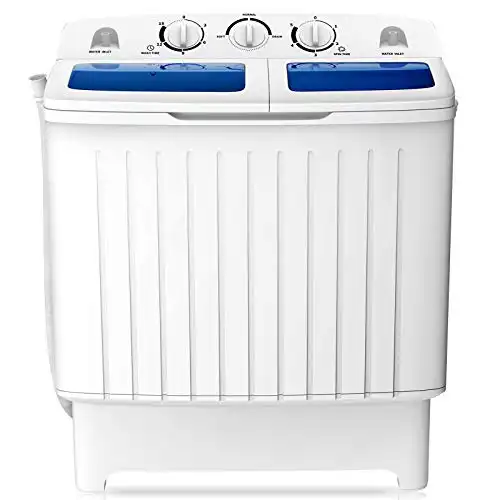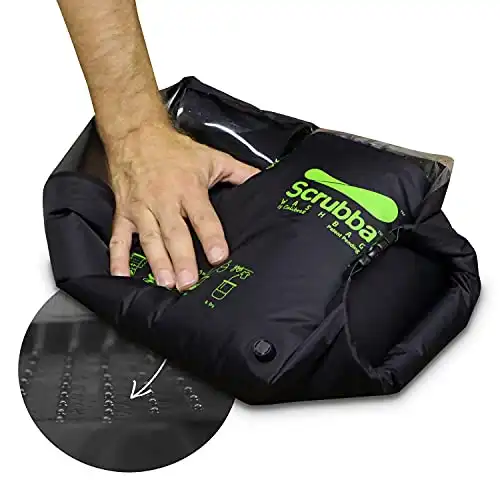RV laundry can be such a headache sometimes! When we bought our first RV in 2018, there wasn’t much info about doing laundry in an RV, so it took us a bit to figure out what we wanted to do.
In this post, I’m going to share all of the options for doing laundry in a travel trailer and give you my best tips for keeping up with laundry while you’re enjoying RV life.
This post may contain affiliate links. As an Amazon Associate, I earn from qualifying purchases. I may receive a small commission when you make a purchase using my links at no extra cost to you. Thank you for your support!
Options for Doing Laundry in an RV
Ok, let’s start by going over the different options you can consider for doing laundry in your RV.
Add a Built-In Washer & Dryer
An obvious option is to add a washer and dryer to your RV. In fact, some new RVs even come with a washer and dryer straight from the dealership.
There are usually two main options that you can choose from if you want to add them to your RV: a ventless washer & dryer combo unit or a vented stackable (or side-by-side) washer & dryer.
We chose to add a washer & dryer combo in both of our RVs, and it has worked well for us. However, there are pros and cons of both options.
Let’s go over a few and compare a ventless washer-dryer combo vs a vented washer and dryer!

Ventless Washer-Dryer Combo Unit
Pros:
- Space-Saving: A combo unit takes up less space than separate washer and dryer units, which is ideal for smaller RVs.
- Convenience: One machine does both the washing and drying – no need to transfer laundry between machines!
- Installation: Installation is easier, as you don’t need to cut a hole in the RV for a vent.
- Energy Efficiency: Many ventless units are designed to be more energy-efficient, which is beneficial for RVers who are conscious about power usage.
- Water Usage: Often, ventless units use less water than their vented units, which is an important consideration for saving water in an RV.
Cons:
- Longer Drying Times: Ventless dryers typically take longer to dry clothes compared to vented models.
- Moisture and Heat: They can increase the humidity and temperature inside the RV as they expel hot air and moisture into the living space.
- Smaller Capacity: Generally, combo units have a smaller load capacity, meaning you might need to do laundry more frequently.
- Less Efficient Drying: Clothes may not come out as dry as they would in a traditional vented dryer, often requiring longer dry cycles.
- Cost: Ventless combo units can be more expensive upfront than a separate washer and dryer.
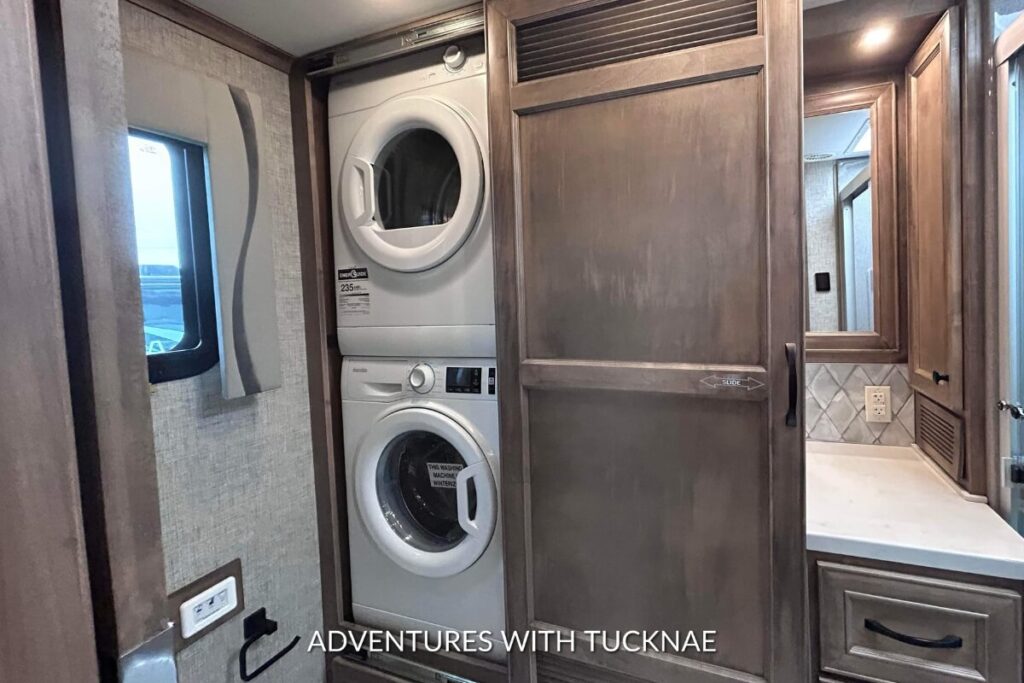
Vented & Stackable Washer & Dryer
Pros:
- Efficient Drying: Vented dryers are typically more efficient at drying clothes as they are faster and more thorough.
- Larger Capacity: Stackable units usually have a larger capacity than combo units, ideal for a large family or less frequent laundry days.
- Less Heat and Humidity Inside: Since the vented dryer expels air outside, it doesn’t increase the indoor humidity or temperature as much.
- Flexibility: Stackable units allow for more flexibility in terms of placement within the RV.
- Separate Cycles: Running the washer and dryer simultaneously can save time when you have more than one load of laundry to wash.
Cons:
- Space Requirements: Stackable units require more space, which can be a limitation in smaller RVs.
- Installation Complexity: The need for external venting can make installation more complex and potentially limit where the unit can be placed. Plus, you’ll need to cut a hole in the side of your RV, which can be scary!
- Energy and Water Usage: These units may consume more electricity and water, which can be a concern for boondocking RVers.
- Inconvenience: Having to transfer laundry from the washer to the dryer can be less convenient.
- Weight: Stackable units can be heavier, adding more weight to the RV, which might be a concern for weight distribution and fuel efficiency.
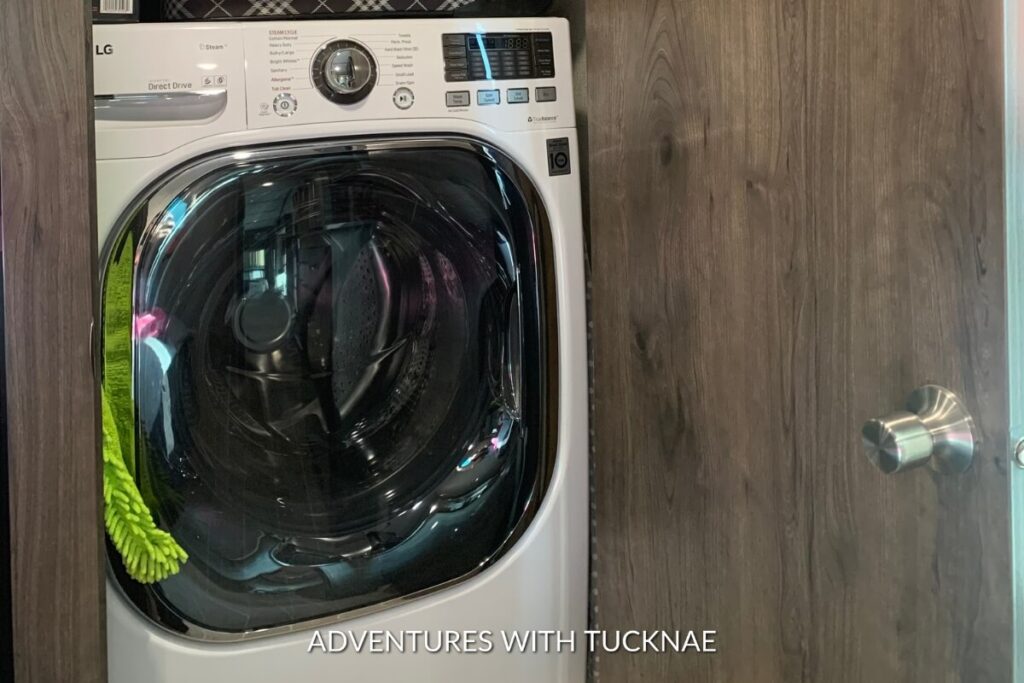
Ok, now that we’ve gone over the pros and cons of each, you’ll see that there’s not really a clear winner.
In fact, if you ask a whole group of RVers which option is better, you’ll get pretty split answers.
My advice is to figure out which option fits your personal needs best.
For us, that was a ventless combo unit. We chose to go this route because it saved us room in our fifth wheel, and with only two of us as full-time RVers, we really don’t go through laundry very fast.
There are multiple brands that you can choose from, but after reading reviews, we chose to go with LG brand combo units for both of our rigs.
Ultimately, if you want to add an RV washer & dryer, do a little research and figure out what is going to fit your rig and your family best!
Wondering where to put your washing machine? We put ours in our RV bathroom.
Some RV renovations are especially creative, like this outdoor kitchen, which was turned into an RV laundry room.

Use a Portable Washer
If you don’t want to use a regular washer & dryer, another option to consider is a portable washing machine.
These are great for those with limited space, but like anything else, they come with their own set of pros and cons. Here are a few!
Pros:
- Space Efficiency: Their compact size makes them ideal for small RVs.
- Portability: They are lightweight and are easy to move and store away when not in use.
- No Permanent Installation Required: Unlike traditional washers, portable washing machines don’t require a fixed water line or drainage system. Many models can be connected to a sink faucet and drained in the sink or shower.
- Lower Water and Energy Usage: Portable washers typically consume less water and electricity compared to full-sized models, making them a great option for RV boondocking.
- Affordability: They are generally more affordable than a large RV washing machine.
- Ease of Use: Most portable washing machines are simple to operate with basic settings and functions.
Cons:
- Smaller Capacity: They usually have a much smaller capacity than traditional washers, limiting the size to small loads of laundry.
- Manual Setup: Each use typically requires manual setup, including connecting the machine to a water source and setting up the drainage.
- Limited Features: Portable washers may lack the advanced features and settings found in full-sized models, such as multiple wash cycles or temperature settings.
- Physical Effort: Moving and setting up the machine can require physical effort, which might be inconvenient or challenging for some users.
- Longer Wash Times: Some models may have longer wash cycles compared to traditional washers.
- Drying Clothes: Portable washers don’t have an integrated dryer, which means you’ll need to air dry your clothes once they are clean.
Here are two popular options:
- 20-pound capacity
- Timer control
- Compact & lightweight (29 pounds)
- Best for small items
- Folds compact to store
- Weighs less than 4 pounds
As you can see, using a portable washer isn’t as easy or convenient, but it’s definitely an option for those with limited space, and it beats handwashing, which is our next option!
Hand Washing
Of course, there is also the option to hand wash your clothes either in your RV sink or in a portable wash bag.
Although it can be time-consuming, it is still possible to hand wash and air dry your clothes when you’re RV camping.
Using something like a Scrubba wash bag can help make the process much easier.
- Extremely compact and lightweight (5 oz)
- Fast & convenient to use
- Perfect for RVing or tent camping
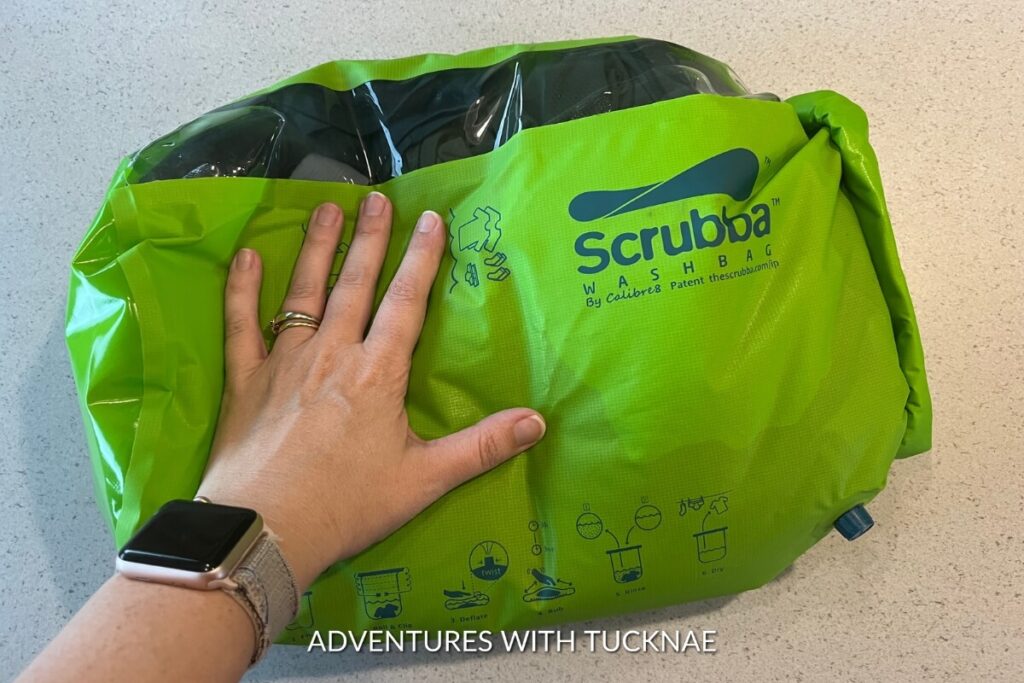
Of course, you will also need to air dry your clothes if you choose to go this route.
A compact clothes drying rack is great to use in your RV, as it takes up minimal storage space but can dry large amounts of clothes.
Another good thing to note is that some RV campgrounds have rules about hanging clothes outside, so be sure to check before doing so.
Utilize Laundromats While Traveling
The final option that we’ll go over is laundromats.
Most towns that you travel through will have at least one laundromat, but you’ll quickly find that they are not all equal.
Some are very nice facilities with great machines, and some are just plain gross.
Of course, reading reviews and looking for images of each laundromat online before visiting can help you avoid the bad ones, but you never really know for sure.
If you are staying at an RV park, check to see if they have laundry facilities. Although not all campground laundry rooms are great either, they’re typically not as bad.
If you do plan to use public laundromats for your laundry needs, make sure to keep plenty of quarters on hand.
Although some modern facilities take digital payments or credit card payments, most traditional laundromats still operate with quarter machines.
Standard washing machines at a commercial laundromat typically range from about $2 to $4 per load.
However, larger, high-capacity machines designed for bulky items or large loads can cost more, sometimes up to $8 or higher.
Dryers usually charge by the time used, often around $0.25 to $0.50 for every 5 to 10 minutes.
A typical drying session might cost between $1.50 and $3, depending on the dryer’s efficiency and the type of clothes.
Additionally, some laundry centers offer laundry detergent and fabric softener for sale should you forget yours or run out.
As you can see, the cost adds up quickly, so having a lot of quarters on hand is a good idea, haha!
If you decide to use laundromats, whether traditional or campground laundry facilities, please make sure to be courteous to others.
- Be prompt to switch your laundry, and don’t leave it unattended.
- Throw away your trash and dryer lint; don’t leave a mess behind.
- If you encounter any issues with the machines, let the staff know or leave a note.
Although they are not the most convenient option, laundromats are plenteous and are a great option for doing RV laundry.

Helpful Tips for Doing Laundry in an RV
Alright, now that we’ve covered five different RV laundry solutions, let’s go over ten quick & helpful tips!
- Plan Laundry Days: Schedule regular laundry days to avoid a buildup of dirty laundry. This helps manage your time and ensures you always have clean clothes.
- Use Space-Efficient Laundry Solutions: Opt for collapsible laundry baskets/laundry hamper or hanging laundry bags that save space.
- Conserve Water and Energy: Choose energy-efficient laundry appliances if doing laundry while boondocking. When handwashing, reuse rinse water for the initial wash of the next load to save your water supply.
- Pre-Sort Laundry: Keep separate bags or bins for different types of laundry (lights, darks, delicates). This saves time on laundry day and makes the process more organized.
- Use Concentrated or Eco-Friendly Detergents: These are better for you (and the environment) and take up less storage space in your RV.
- Maximize Laundromat Visits: If using a laundromat, try to do all your laundry in one go. Try to go during off-peak hours to avoid waiting for machines!
- Maintain Laundry Appliances: Regularly clean and maintain your washer and dryer unit. This includes cleaning lint traps and checking for any blockages or maintenance needs.
- Manage Moisture: When drying clothes inside, use a dehumidifier or open windows. We also keep a DampRid container directly next to our combo unit, and it always fills up fast!
- Wear Clothes More Than Once: To reduce the frequency of laundry, wear clothes more than once when possible, especially items like jeans or outerwear.
- Quick-Dry Fabrics: Opt for quick-dry fabrics, especially for towels and athletic wear, which can reduce drying time and space requirements.
Tips for Doing Laundry While Boondocking
We are not traditional RVers in the sense that you’ll rarely find us at RV parks or campgrounds. Instead, we prefer boondocking.
That being said, it does make laundry just a bit more challenging due to the lack of amenities.
Here are some tips we’ve learned for laundry while boondocking.
- Wait for a Full Load: Don’t do laundry until you have a full load. Water is very precious when boondocking, so maximizing what you have is crucial.
- Wear Clothes Multiple Times: As I mentioned before, wearing clothes more than once can really keep things from piling up. Obviously, if it’s dirty, don’t wear it again, haha!
- Only Use Your RV Laundry Machine With Hookups: Don’t make the same mistake we did! We tried to do laundry when our tank was too close to full, and it backed up into our RV. Now, we only do laundry when we have full hookups.
- Plan RV Park Stays Between Boondocking Locations: When boondocking, we can usually go for 10-14 days without needing hookups. After that, we try to book a night or two at a Passport America campground to catch up on laundry and cleaning.
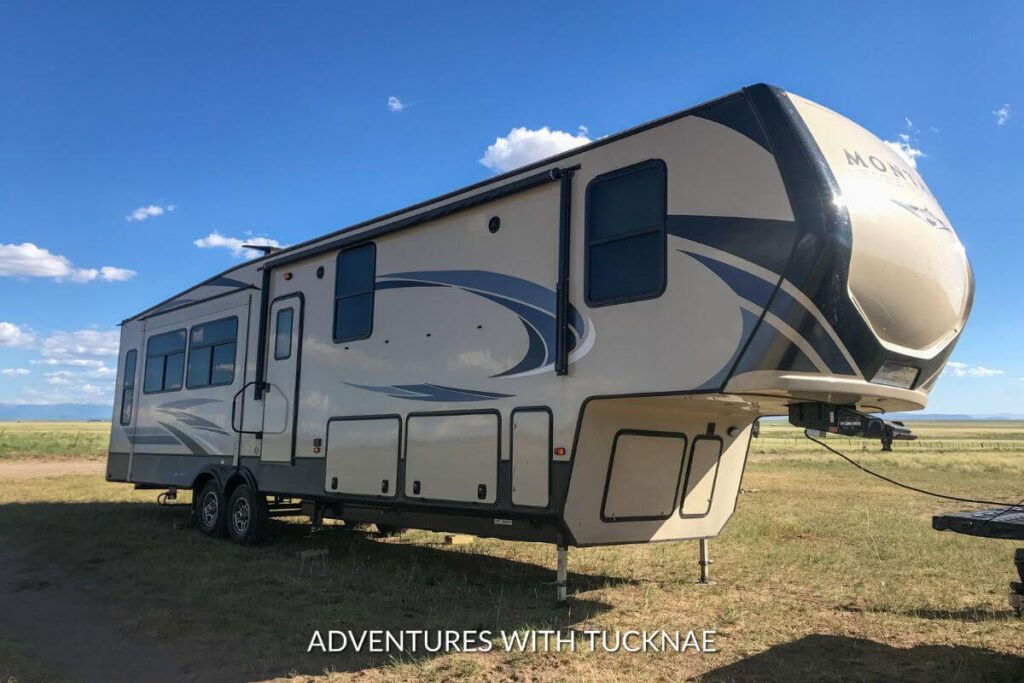
In Closing: RV Laundry Solutions
I hope you’ve found these tips helpful and feel more prepared to tackle your own RV laundry!
Find More RV Tips & Advice
- Advice to Newbie RVers from 32 Full-Time RVers
- 8 Tips to Prepare for RV Travel Days
- 21 Unique Jobs for Full-Time RVers
- 7 Important RV Living Safety Tips
- RV Tip: How To Keep Glass Plates From Breaking in an RV
- Winter RV Camping Guide: 13 Tips for RVing in Cold Weather
- Easy RV Hot Water Heater Maintenance Guide + Cleaning Tips
- 101 Inspirational RV Quotes & the Best RV Camping Captions
- The 60+ Best RV Games For Indoor & Outdoor Camping Fun
- A Full-Time RVers Complete Guide to RV Laundry Solutions
- 10 of the Best RV Plants to Grow in an RV
Let me know in the comments which of these ideas for laundry in an RV you are going to try!

